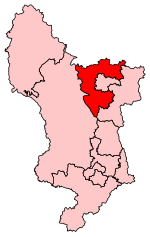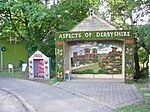Wadshelf
AC with 0 elementsDerbyshire geography stubsNorth East Derbyshire DistrictTowns and villages of the Peak DistrictVillages in Derbyshire

Wadshelf is a small village in Derbyshire, England. It is located between Chesterfield and Baslow, just inside the Peak District national park. It is near to Wigley, Holymoorside, and Brampton. The name is believed to be a corruption of Watch Hill. The village has a pub, The Highwayman on the main A619 road. Wadshelf is in the civil parish of Brampton.
Excerpt from the Wikipedia article Wadshelf (License: CC BY-SA 3.0, Authors, Images).Wadshelf
Baslow Road, North East Derbyshire Brampton
Geographical coordinates (GPS) Address Nearby Places Show on map
Geographical coordinates (GPS)
| Latitude | Longitude |
|---|---|
| N 53.233 ° | E -1.529 ° |
Address
Baslow Road
Baslow Road
S42 7BU North East Derbyshire, Brampton
England, United Kingdom
Open on Google Maps










